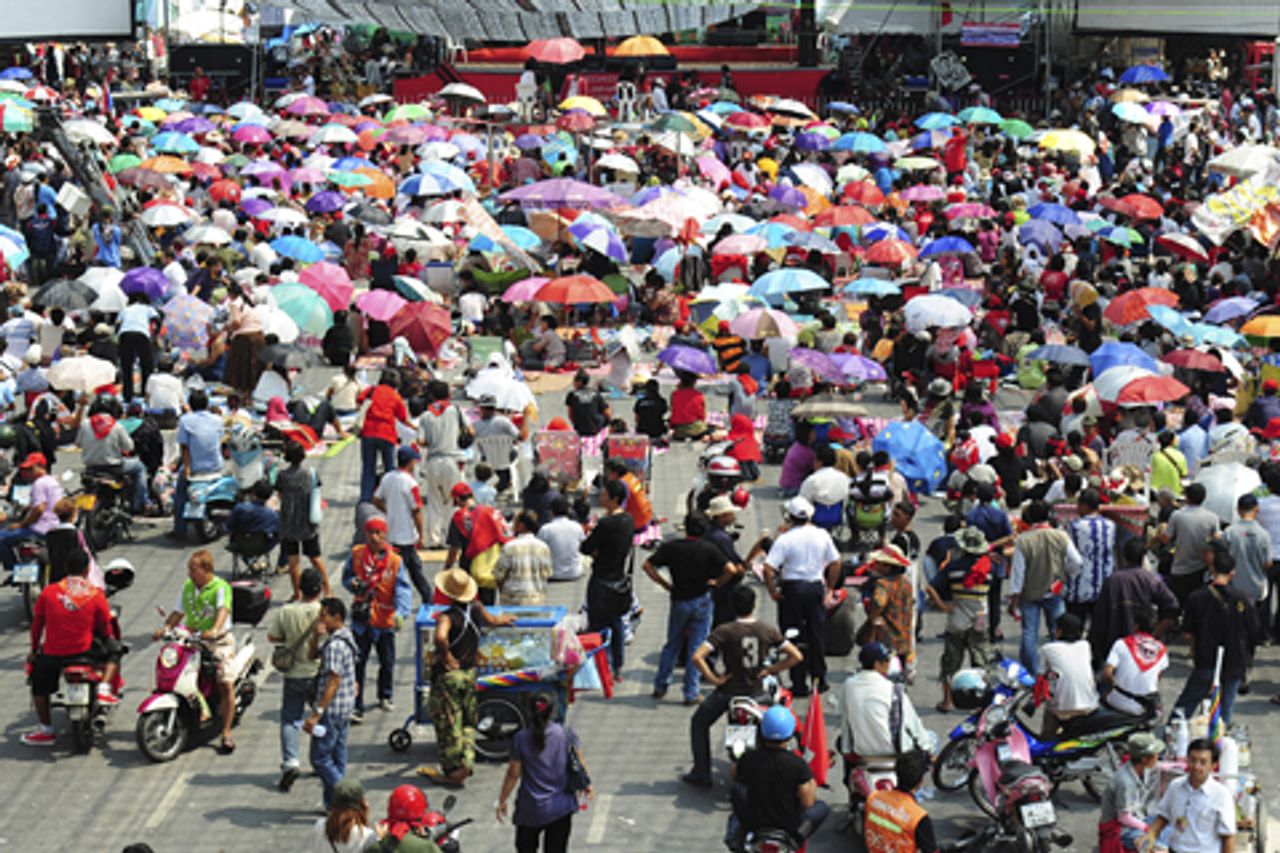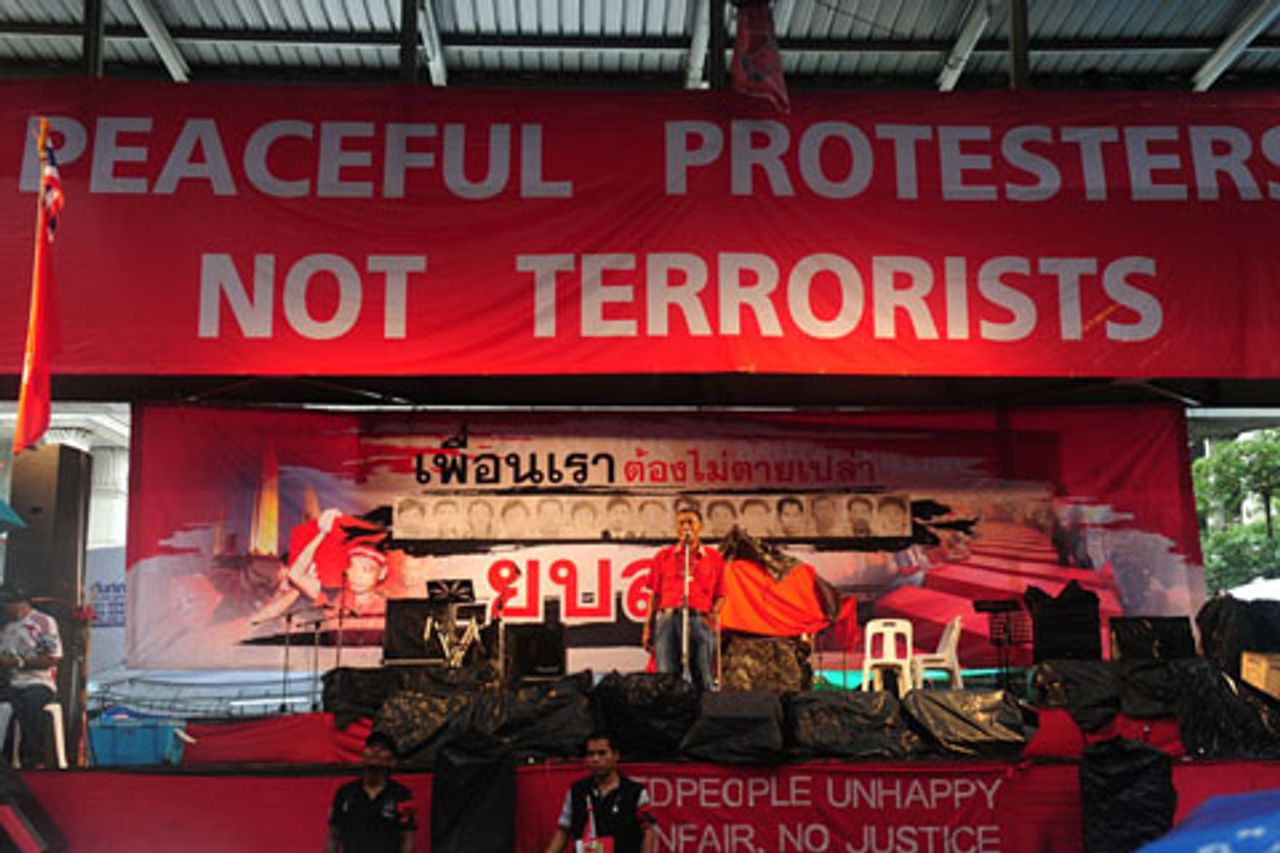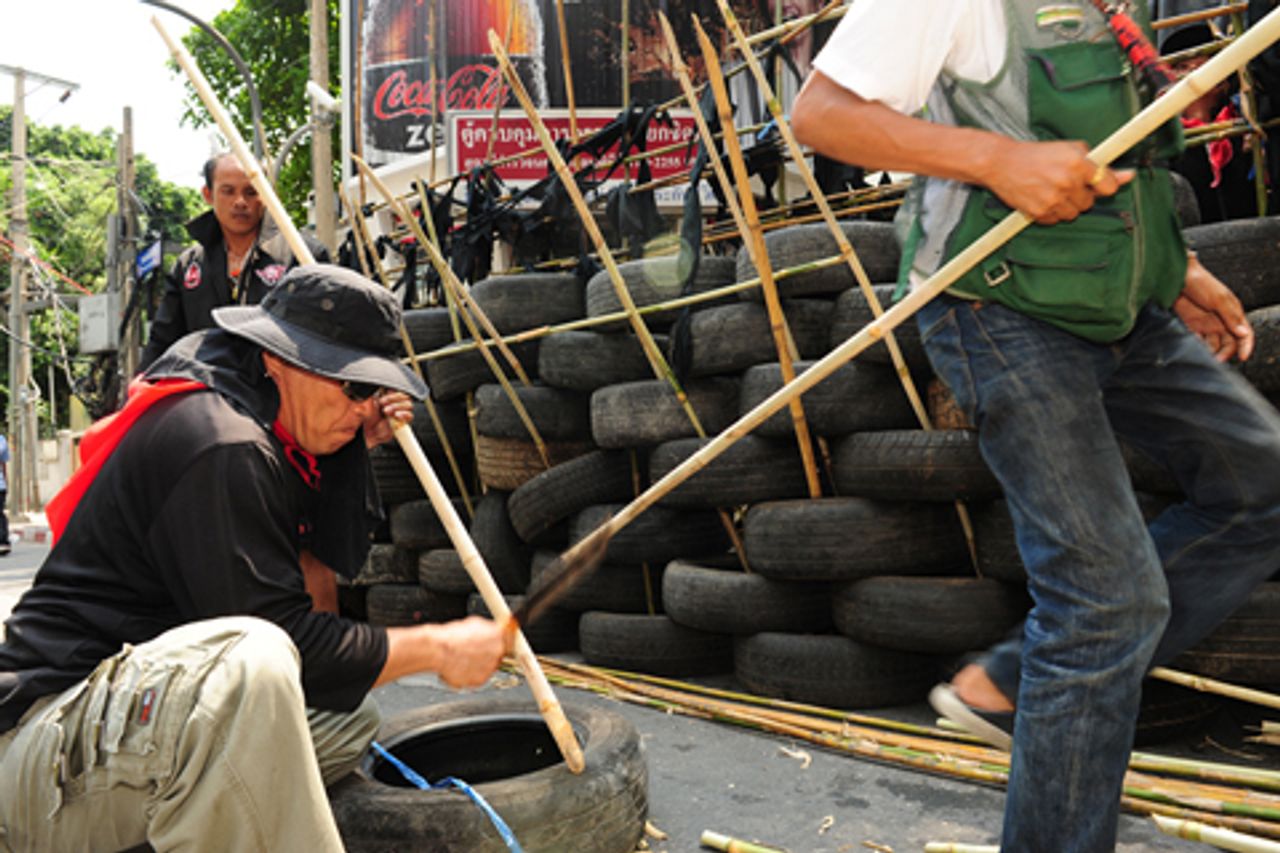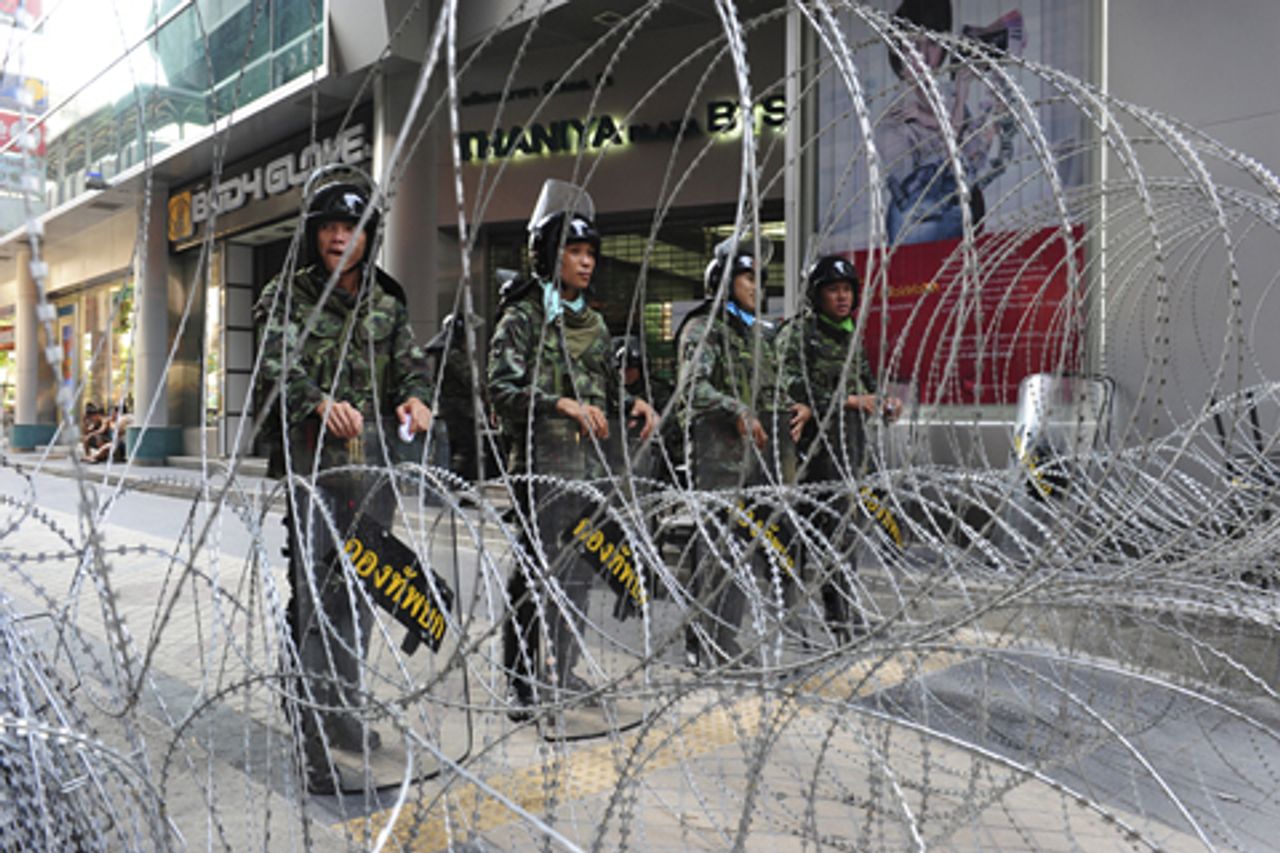The standoff between anti-government protestors and security forces in Bangkok is continuing after a clash on Wednesday left one soldier dead and two others injured, along with 16 protestors. The clash took place as about 2,000 demonstrators attempted to break through barriers surrounding their protest site in the Ratchaprasong area.
At least 27 people have now died since the United Front for Democracy Against Dictatorship (UDD) began its protests in mid-March to demand the dissolution of parliament and fresh elections. Most of the deaths occurred in street fighting on April 10 when heavily armed soldiers and police attempted to clear the original UDD protest site at the Phan Fah bridge.
 UDD rally in Bangkok's Rachaprasong district
UDD rally in Bangkok's Rachaprasong districtSince then the UDD has consolidated its protest in the capital’s glitzy Ratchaprasong commercial district, erecting barricades of netting, tyres and sharpened stakes. The security forces have thrown up roadblocks and declared that the protestors will not be allowed to move to other parts of the city. While Prime Minister Abhisit Vejjajiva has declared a state of emergency, the government and military have been reluctant to move in, fearing a bloodbath that would trigger a new wave of protests.
Wednesday’s clash occurred when a large group of demonstrators attempted to move on motorcycles and pickup trucks to the Talad Thai fish market to thank supporters. UDD leader Kwanchai Praipana told the protestors: “If the troops try to stop us, we will break through their cordons and checkpoints.” Fighting erupted on the Vibhavadi-Rangsit Road after soldiers refused to allow the procession through, and lasted for more than an hour. Police and troops fired rubber bullets and live ammunition. UDD protestors replied with stones and firecrackers. The soldier killed was apparently shot accidentally by fellow soldiers.
 UDD leaders address protest
UDD leaders address protestIn the course of the clash, air force personnel stopped a motorcyclist, who fled leaving behind grenades and several grenade launchers along with an ID card identifying the rider as a police sergeant-major. Arrested yesterday, he admitted selling the weapons but denied working within the UDD. The incident raises further questions about the government’s claims that “terrorists” among the UDD protestors were responsible for the April 10 violence and a series of subsequent grenade attacks. The UDD has insisted that police or army provocateurs are working to create the pretext for an all-out assault on its protest site.
Wednesday’s clash came the day after UDD protestors stacked tyres on a station platform of Bangkok’s elevated rail system. The system, which carries 450,000 passengers a day, was shut down for four hours during the morning rush period.
Following Wednesday’s confrontation, Deputy Prime Minister Suthep Thaugsuban declared that “it won’t be long” before the military acts to remove the protestors. The government is under pressure from business groups to put an end to the UDD demonstrations which have impacted on foreign investment, tourism and the share market as well as five-star hotels and shopping malls in the Ratchaprasong area.
The UDD supports the exiled former Prime Minister Thaksin Shinawatra, who was ousted in an army coup in 2006. While in office from 2001, Thaksin built up a base of support among the rural poor in the country’s populous north and northeast through limited handouts as part of his bid to stimulate the economy. Thaksin is bitterly opposed by sections of the traditional Thai elites—the military, the state bureaucracy and the monarchy—who turned on him when he continued to open up the Thai economy to foreign investors and cut across established patronage networks.
The military junta rewrote the constitution and called a national election in 2007, which was won by a pro-Thaksin party, setting the stage for months of confrontation with anti-Thaksin protestors organised by the Peoples Alliance for Democracy (PAD). Two pro-Thaksin governments were ousted through court rulings over alleged electoral corruption before Abhisit was installed in December 2008 with the assistance of the military.
Yesterday, PAD stepped up its demands for action to end the UDD protests by holding rallies outside 40 military bases nationwide. A petition declared: “The crisis has reached a critical point and has damaged the economy and society.” Describing the situation as “a state of anarchy,” it called on “our brave soldiers [to] help us get rid of this illegal activity”. PAD leader Chamlong Srimuang has called for martial law to be imposed and warned of civil war if the UDD demonstrations were not halted.
 UDD street barricades
UDD street barricadesThe PAD protests will only further inflame tensions. Drawing on layers of the Bangkok middle class and backed by the traditional elites, including the monarchy, PAD attempted to paralyse the pro-Thaksin government in 2008. It firstly blockaded government house in central Bangkok, then took over the capital’s two main airports, while the security forces stood by. PAD is quite capable of a violent provocation that would be used by the military to crack down on the UDD protests.
The political battle between the pro- and anti-Thaksin factions of the Thai ruling elite has nothing to do with the defence of democratic rights on either side, but results from sharp differences over economic policy and control of the state apparatus. Large numbers of the rural and urban poor have joined the protests and begun to raise their own demands for decent living standards, provoking fears in business circles in Thailand and internationally that the political crisis is spiralling out of control.
 Police and military preparations
Police and military preparationsThe international press has commented in increasingly worried tones, calling for a negotiated solution but noting the intractable character of the crisis. An article in yesterday’s UK-based Guardian described the Abhisit government as operating “like a civil military junta” with “Gestapo-like legal powers” that had “tugged” itself into the monarchist corner dependent on the military. While saying a compromise was the “only answer”, the newspaper warned: “Thailand’s near-term prospects will remain problematic and its long term horizon murky.”
The Economist magazine was just as gloomy. Yesterday’s comment “Trying to avert another bloody showdown” concluded: “Royalist hysteria has long been PAD’s calling card. Worryingly it has been taken up by Mr Abhisit and his security chiefs. On April 26 their operations-centre claimed to have unearthed a secret anti-monarchist plot by red-shirt [UDD] leaders and other opposition figures. Denials came fast and furiously, along with dark warnings of how such smears can be used to justify violent repression, as was the case in October 1976. To avert the tragedy of a repeat performance, both sides need to keep their hardliners in check.”
In October 1976, police, soldiers and para-military units with the tacit support of the king unleashed a violent crackdown on students and protestors at Thammasat University and at Sanam Luang in Bangkok. The official death toll was 46, but the actual figure was much higher as the security forces shot and bludgeoned protestors and mutilated their bodies. The massacre was followed by a coup and the installation of a military-backed junta.
Stories of a plot against the king could well be used as the pretext for a similar crackdown that would be likely to have far broader ramifications. Unlike 1976, a bloody massacre in Bangkok could trigger retaliation among the rural poor in the country’s north and northeast.
